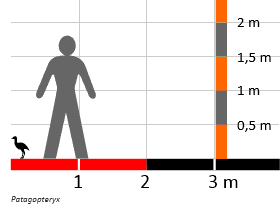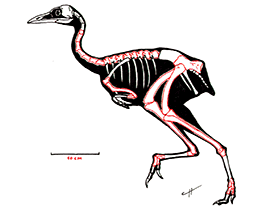Patagopteryx deferrariisi

Chiappe, Calvo, 1994
Klassifizierung: Euornithes
Ernährung: omnivor
Bedeutung des Namen: Flügel aus Patagonien
Der Fund des Patagopteryx besteht aus insgesamt 3 Exemplaren, der Holotypus ist ein unvollständiges postcraniales Skelett mit 18 Wirbeln, dem Synsacrum, ein Großteil des Brust- und Beckengürtels sowie der Flügel und der Beine. Patagopteryx war etwa so groß wie ein rezentes Huhn, besaß kräftige Beine und einen bezahnten Schnabel. Die Flügel dieses Vogels waren zurückgebildet, er war nicht flugfähig und lebte am Boden, seine Nahrung bestand vermutlich aus Früchten und Kleinlebewesen
Länge: 60 cm
Gewicht: 1 kg
Holotyp: MACN-N 03
Fundort: Bajo de la Carpa Formation, Boca del Sapo, Provinz Neuquén, Argentinien

© Dinodata.de

© Martin Chavez

© Nix Illustration
Weitere Informationen
A new flightless landbird from the Cretaceous of Patagonia / H. M. F. Alvarenga, Jose F. Bonaparte. 1992 / Natural History Museum of Los Angeles County Science Series, 36, pp. 51-64
Late Cretaceous birds of southern South America: Anatomy and systematics of Enantiornithes and Patagopteryx deferrariisi / Luis M. Chiappe, 1996 / Munchner Geowissenschaftliche Abhandlungen 30, pp. 203-244
Osteology of the Flightless Patagopteryx deferrariisi from the Late Cretaceous of Patagonia (Argentina) / Luis M. Chiappe, 2002 / In: Mesozoic Birds, Above the Heads of Dinosaurs, Chapter: 13. University of California Press, Editors: Luis M. Chiappe, Lawrence M. Witmer, pp. 281-316
- - - - -
Bildlizenzen
Größenvergleich / © Dinodata.de:
 Creative Commons 4.0 International (CC BY 4.0)
Creative Commons 4.0 International (CC BY 4.0)
Patagopteryx /
© Nix Illustration:
 Creative Commons NonCommercial International 4.0 (CC BY-NC 4.0)
Creative Commons NonCommercial International 4.0 (CC BY-NC 4.0)
- - - - -
Grafiken und Illustrationen von Martin Chavez



